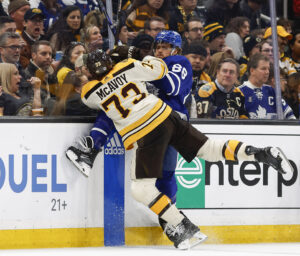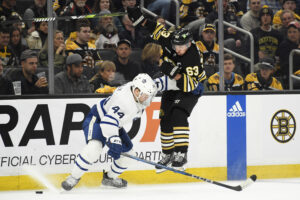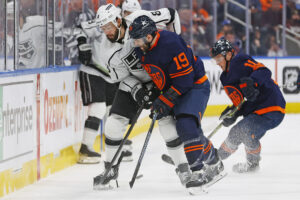Previous explorations of the Vancouver Canucks draft history have shown what can be charitably described as a mixed bag. A few great picks – especially in recent years – and some that, well, didn’t work out. There were a couple curious discoveries, like the Canucks drafting 10th more frequently than any other position. Here are parts One, Two, and Three.
But here, finally, with draft slots 21 through 25, we have pain. Two of the worst ever Vancouver Canucks draft picks (and one serious miss) are coming up. Those fans of a sensitive disposition may want to skip this one.
The Best First Round Vancouver Canucks Draft Picks
Twenty-First Overall Pick
Choices: Libor Polasek
They did much better with their next pick in 1992 (the aforementioned Mike Peca). Polasek was a bewildering choice, with nothing to suggest he’d make a big impact other than his size. And he WAS a big boy at 6′-4″ and 220 pounds by the time he was 18 years old. But otherwise? His skating was okay, but his production was modest at best and he didn’t have any sort of mean streak. Still, they took a chance and totally blew it. To be fair, it was a wildly hit-or-miss year for the draft and only two players in the next ten taken reached 200 NHL games. Which would help justify the selection if Polasek made any impact on any league at any point in his career. He didn’t. This is one of the Canucks worst selections.
Verdict: Polasek
Twenty-Second Overall
Choices: Jeff Bandura, Curt Fraser, Jordan Schroeder
Jeff Bandura made it to the NHL, but barely. The tough-as-nails defender played two games with the New York Rangers, picking up one assist. Schroeder is a classic “tweener” – solid enough AHL player to give a team hope. He got a couple more chances with expansion teams the Minnesota Wild and the Columbus Blue Jackets and eventually to the KHL. Curt Fraser was a local(-ish) boy who played his junior days in Victoria, BC. He was a big part of the Canucks’ miracle Stanley Cup run in 1982, but even more than that he was traded. The return from the Chicago Blackhawks (that’s how it was written then) was their first true sniper and scoring star, Tony Tanti.
Verdict: Fraser, easily
Twenty-Third Overall
Choices: Ron Sedlbauer, Jiri Slegr, Nathan Smith, Ryan Kesler, Brock Boeser
Sedlbauer had a decent career. The left-winger played most of his seven years in Vancouver, getting 177 points in 325 games. Smith was another swing-and-a-miss for the Canucks trying to get a scoring centre. Didn’t look like it at the time, as Smith’s draft plus one year, saw him get 90 points in 67 games. Unfortunately, he never scored a point in the NHL. It wouldn’t hurt so much if Brad Boyes, Steve Ott, Justin Williams, and Niklas Kronwall weren’t all chosen with the next six selections. All four played 800 or more NHL games.
Still, the other selections at 23rd are pretty solid, to say the least. Jiri Slegr is a Stanley Cup winner – barely – and enjoyed a 622-game NHL career. Kesler became a legendary pest – occasionally to management – and one of the most hated players in the league – occasionally to his teammates. See the last entry for a bit of that. Still, he is the team’s only Selke winner and has played 1,001 NHL games, many as an excellent second-line centre.
Challenging him is one of the best shooters the Canucks have ever had in Brock Boeser. Boeser’s style of threat is rather different from Kesler’s, having as many penalty minutes as even-strength goals (52). Injuries have struck Boeser early, limiting him to just 188 games in three full seasons. That he got 156 points in those games is hard to ignore, but longevity counts. FOR now.
Verdict: Kesler
Twenty-Fourth Overall
Choices: Rob Murphy, Hunter Shinkaruk, Jared McCann
Murphy was another victim of the “draft him because he’s big” philosophy of the 1980’s Vancouver Canucks draft philosophy. He produced well in the minors before eventually heading to Germany for six seasons. His best shot at the NHL was when he was chosen from Vancouver by the Ottawa Senators in their expansion draft. As for the other two, they are two of general manager Jim Benning‘s more controversial trades.
After just one game with the Canucks, Shinkaruk was traded to the Calgary Flames for Markus Granlund. The reasoning at the time was that the 2011 team had sacrificed a lot of their future for the Stanley Cup run – which was true – and they needed to “fill in” those otherwise missing draft picks who would have been in their third and fourth pro years. Whether that was such a big absence is debatable, and bringing in a player who hadn’t quite established himself for a recent draft pick was, too. As loud as the debate got, history is on Benning’s side. After just 15 NHL games, Shinkaruk is in the KHL. Granlund is too, but at least he played 335 games in The Bigs.
Not so clear-cut is McCann’s move. He was put on the Canucks straight out of the minors, getting nine goals and 18 points in 69 games as a rookie. The team moved him out for defensive help in the form of the large and surly Erik Gudbranson. Gudbranson spent three injury-filled, hugely unpopular years in Vancouver before getting traded for reclamation project Tanner Pearson. McCann, on the other hand, is growing into a third-line centre with the Pittsburgh Penguins and has 52 goals and 123 points in five years.
Verdict: McCann
Twenty-Fifth Overall
Choices: Patrick White, Troy Gamble
First off, Troy Gamble looked like he was going to be a challenger to this Kirk McLean kid. They more-or-less split the 1990-91 season, and Gamble had better numbers. They both got smoked in the playoffs, but that happened a lot to Vancouver. The next year, McLean TOOK OVER, far outplaying Gamble and taking every minute of the Canucks 13 playoff games. The 19 games Gamble played that season were his last in the league. Still, he finished with 72 for his career, which is better than you or me.
And… Patrick White. Now, 2007 was not a great draft year. A lot of teams had a pretty miserable time of it. The New York Islanders, for instance, only had one player make it to the NHL – Mark Katic – and he only played 11 games. Of course, they only had five selections, and none in the first two rounds. The Ottawa Senators only had four selections and still got 77 games from Jim O’Brien. The Vancouver Canucks draft was worse. Not a single NHL game played from any of their six selections. And the lightning rod for their failure was Patrick White.
Patrick White
White had to go through not only fans’ disappointment with him, but their disappointment with the draft year. It didn’t help that the two players selected after him – David Perron and Brendan Smith – are both playing in the NHL. White was a bit of a surprise pick. He was fine in high school: he won several accolades, including a Mr. Hockey finalist and a couple All-State first-team nominations. He was good enough to represent the US in the 2007 U-18s. But he simply wasn’t worth the 25th overall slot, even in an indifferent year. That “First Round Selection” tag hung on him, heavier than he deserved. He may be one of the worst selections the Canucks ever made, but the worst? I’m going with Polasek on that one.
After four years fighting to get a place on the powerful Minnesota Golden Gophers squad, White spent his entire pro career in Europe.
Verdict: Gamble
We can’t blame the players for their draft positions any more than you can blame them for signing an offered contract. Even so, it’s more understandable when later picks don’t make it. And a pleasant surprise when some do. Being a first-round pick doesn’t mean as much when you get past a couple dozen selections, but the next dozen players will always have that if not much else to show for their pro careers. We’re wrapping up the Vancouver Canucks draft selections 26 through 31 next.
Main Photo:






